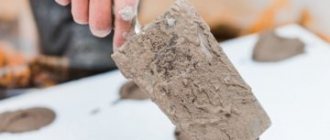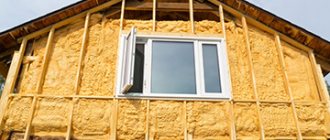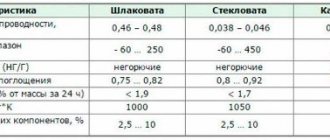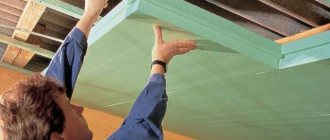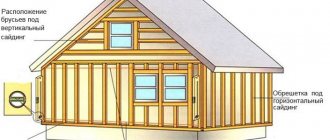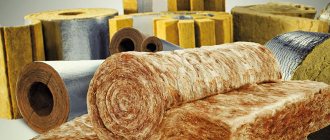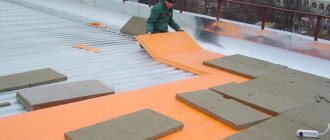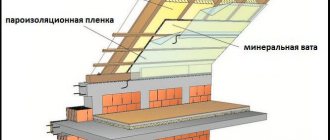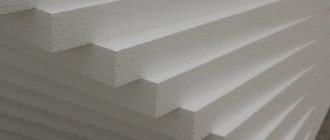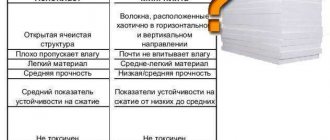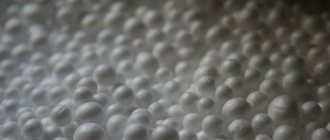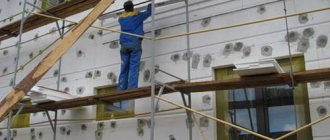Is it possible to insulate an attic with polystyrene foam?
To insulate an attic with your own hands, the choice of building materials is based on the environmental component. Expanded polystyrene is a product of synthetic origin. When the plates are heated (+25-+30 degrees Celsius), phenol, acetophenone, and methyl alcohol are released. Inspecting authorities claim that the amount of substances complies with acceptable standards. Today, manufacturers are using new technologies for the production of synthetic insulation aimed at reducing the content of residual harmful products. To simplify the choice of polystyrene foam for the buyer, finished products are divided into 2 groups:
- Technical expanded polystyrene is used for work on facades, non-residential buildings, and in road construction.
- Household insulation can be installed with your own hands inside a residential or social facility.
However, there are restrictions on the use of polystyrene foam regarding the type of structure. The addition of fire retardants reduces the melting and combustion temperatures, but it is impossible to completely eliminate this property of the thermal insulation material. When using polystyrene foam to insulate an attic roof, experts recommend using non-combustible roofing and decorative finishing. And the electrical wiring must additionally be insulated with a corrugated plastic pipe or hidden wiring should be eliminated altogether.
Pros and cons of insulating the attic from the inside with foam plastic
Low-density polystyrene foam crumbles and breaks a lot.
The choice of polystyrene foam for attic insulation is often based on the low cost and light weight of the material with strict geometric shapes. However, expanded polystyrene has other advantages:
- The thermal conductivity coefficient is limited to 0.032-0.044 W/m*K, which is lower than some options for mineral insulation.
- The density of foam plastic has relatively low values, which is important for ensuring minimal load on the supporting sheathing and rafters, load-bearing structures and the foundation of the building. The low weight of the slabs also simplifies the DIY installation process, during which there is no need for special lifting equipment.
- Water absorption is 0.2%. This fact does not limit the use of polystyrene foam with respect to humidity indicators. This means that you can insulate a room, a bathroom, walls inside and outside the attic.
- Inertness to biological damage. The synthetic base of expanded polystyrene does not promote or support the development of bacteria, fungus, mold and moss.
- Ease of processing. To insulate the attic from the inside with polystyrene foam with your own hands, it is enough to have a construction knife, a hacksaw with a fine and fine tooth. Less commonly, an electric jigsaw or reciprocating saw is used to speed up the DIY installation process. The cutting of slabs is carried out without significant effort and quickly.
Important!
When choosing a thermal insulation material, you need to consider the coefficient of thermal expansion of the insulation. The mansard roof has a rafter support system. As a rule, wooden beams are used to organize the frame. Foam plastic is characterized by a lack of plasticity, which causes a low risk of cold bridges and eliminates mechanical impact on the sheathing.
Depending on the density of the foam, installation, the service life of synthetic insulation can be 10-15 years or more, up to 30. Extruded polystyrene foam retains its quality characteristics and physical parameters longer. The material also copes better with exposure to ultraviolet radiation, but protection is still required.
Along with the tangible advantages of expanded polystyrene, there are disadvantages that are important to consider before making the final choice of one or another insulation:
- The low vapor permeability of polystyrene foam causes poor breathability. These facts contribute to the formation of condensation on windows, walls and ceilings, and the accumulation of carbon dioxide in the room. Such consequences can be eliminated only by organizing a ventilation gap in the body of the structure, forced or natural ventilation of the internal space of the attic.
- Low resistance to sunlight. Often you have to carry out repairs with your own hands in stages; the insulation is left open for some time. Foam plastic, regardless of composition and density, will begin to change color and crumble within a month.
- The weak resistance of polystyrene foam to solvents must be taken into account during finishing work. Many chemically aggressive substances lead to the destruction of slabs almost instantly.
- The low strength of synthetic insulation leads to deformation of the slabs under the influence of any type of mechanical load. Under pressure, density and thermal conductivity change for the worse.
As a result of contact of polystyrene foam with acetone, the material is destroyed.
In addition to negative technical characteristics, disadvantages include the attractiveness of the thermal insulation material to mice and rats.
They easily gnaw channels in foam plastic slabs for movement, warm burrows for hibernation, and nests for reproduction. This significantly increases heat loss on the attic roof.
Varieties
Expanded polystyrene is a type of synthetic polymer or plastic that is widely used in production . Several types of roof insulation are produced from it. Depending on the production method, there are 2 main types of thermal insulation materials based on it:
- Regular foam.
Conventional foam is produced by foaming polystyrene foam under the influence of air or carbon dioxide. This is a lightweight, inexpensive, non-flammable insulation with excellent thermal insulation qualities.
The weakness of conventional foam plastic is the fragility of the boards; this material is extremely susceptible to pinpoint impacts that can damage the sheet. It has low strength, higher thermal conductivity and permeability, and is also cheaper. To insulate the roof, foamed polystyrene foam with a sheet thickness of 100-200 mm is used.
Roof insulation with foam plastic
Characteristics of different brands of foam
- Extruded polystyrene foam.
To produce this insulation, the extrusion method is used. First, polystyrene foam granules are mixed with a blowing agent under high pressure and temperature, and then extruded through an extruder.
The result of these actions is a denser, solid insulation with a closed fine-cell structure. It has higher mechanical strength, does not allow water and steam to pass through, and also has improved thermal insulation characteristics.
Extruded polystyrene foam for roofing is more expensive than usual, however, thinner sheets are used for insulation. Experienced roofers believe that it is better suited for thermal insulation work.
Extruded polystyrene foam
Comparison of polystyrene foam and extruded polystyrene foam
Important! Although polystyrene foam is a non-hygroscopic and vapor-proof material, roof insulation is carried out using a waterproofing and vapor barrier membrane. The membrane that protects the insulation from steam penetration is fixed on the inside of the roof, and the membrane that protects from moisture is fixed on the street side. This measure, together with exhaust ventilation, will help extend the life of the roof truss frame.
Foam thickness for attic insulation
The risk of condensation and the level of heat loss depend on the choice of thickness of synthetic insulation. The thinner the attic structure, the larger the layer of foam that must be organized. When determining this parameter of slabs, the following criteria are taken into account:
- climatic features of a particular area;
- thickness of the attic walls;
- building materials from which the roof of the building is erected and finishing is carried out.
The choice of which polystyrene foam to insulate an attic roof is based on the density and location of the insulating boards. It looks like this:
- For a flat roof, the current figure is 35 kg/cubic meter. m, which corresponds to a thickness of polystyrene foam of 50-100 mm.
- The slopes of the attic roof are insulated with polystyrene foam with a density of 15 kg/cubic meter. m high, close to 100 mm.
- For the walls, thermal insulation boards with a density of 25 kg/cubic meter are used. m. As a rule, a thickness of 50 mm is sufficient.
There is a general formula for calculating the thickness of insulation. The value is obtained by multiplying the thermal resistance of the walls of a residential premises, characteristic of a particular locality, by the thermal conductivity coefficient of the selected thermal insulation material.
For example, for the north-west the thermal resistance limit is 3.08 sq.m.*K/V. A wall of 1.5 bricks has a resistance of 1.06 sq.m.*K/V. If we take expanded polystyrene with a conductivity of 0.039 W/m*K, then slabs 78 mm thick will be needed to compensate for heat loss.
Are polystyrene foam and polystyrene foam the same thing?
Expanded polystyrene is superior to polystyrene in all respects and is therefore more expensive
Both materials are produced from polystyrene using different technologies. The classic foam plastic we are familiar with is obtained by steaming in the form of microgranules, which increase from high temperature and fill the volume of the block mold. The result is a lightweight material from polystyrene shells sintered together and filled with air.
Expanded polystyrene, produced by extrusion, is a material with a solid structure, including small gas-filled cells. Thanks to the technology, a more dense, waterproof, durable material is obtained. Insulating a roof with expanded polystyrene will cost more, but will allow you to get a thinner layer of thermal insulation with good sound absorption, better fire resistance and a longer service life. This material is practically irreplaceable when thermal insulation of a flat roof and floors is being used. Expanded polystyrene is good not only for roofing, but also for insulating the gables of a gable roof without large losses of useful living space.
Related article: How to fill a garage roof to prevent leaks
The operating technology is the same for both materials. In the future, insulation of building roofs with foam plastic will be considered.
How to choose polystyrene foam for insulating an attic roof
Classification of synthetic insulation is carried out based on production technology. Material made by baking is labeled as PSB (foamed) or EPS. Extruded polystyrene foam PS or XPS is sold through the press. Regarding density and application, the following types of PSB thermal insulation boards are distinguished:
- S-15 - relevant for work with a mansard roof;
- S-25 - more often used for flooring;
- S-35 - foundation, utilities, facades in harsh conditions;
- S-50 - any structures with high mechanical load.
There is also technical polystyrene foam labeled A. It is used for foundation insulation. Synthetic material of class K is allowed only for interior work. It is better to insulate an attic with foam plastic under a soft roof from group C, since its strength characteristics are higher than other analogues in its group.
A gap of 10-15 mm is left between the frame and polystyrene foam, then it is filled with polyurethane foam
Technology of internal insulation of flat roofs
When asked whether it is possible to insulate a flat roof with foam plastic from the inside, the best answer would be a description of the technology, which consists of three stages:
- preparation of the roof surface;
- installation of an insulating layer;
- fixing the insulation.
Preparatory work involves thoroughly cleaning and drying the roof surface. When insulating a flat roof, the quality of this procedure affects the degree of strength of the foam fastening: a detailed surface provides sufficient adhesion of materials.
Rice. 11. Internal insulation of a flat roof
The procedure for installing a hydrobarrier is no different from the technology used to insulate a roof located at an angle. You can do it yourself.
The fastening of the thermal insulation layer, as in the case of a sloping roof, is carried out using glue and dowels. However, you need to take into account that when installing the finishing layer of the ceiling, the load on the insulation layer will increase, so it must be fastened very carefully. The ideal option for decorative finishing of the ceiling would be to install a suspended structure. In this case, it is better to strengthen the roof frame by installing a control profile.
How to prepare an attic for foam insulation
Due to the low vapor permeability of expanded polystyrene, there is a risk of condensation, which is detrimental to wooden or metal roof rafters and supporting lathing for thermal insulation. Therefore, it is important to first clean the structural elements and install protection. For this purpose, anti-corrosion or antiseptic compounds are used.
Important! You need to choose universal protective equipment suitable for work inside and outside the attic. They are environmentally friendly and resistant to variable operating conditions.
Before laying expanded polystyrene slabs, it is necessary to organize waterproofing. Since synthetic insulation is chemically unstable, fabrics and liquids without bitumen and solvents are used. If polyethylene or membrane-type materials are used, then they are attached to wooden rafters using staples and a construction stapler. To avoid damage, an additional thin beam is laid. Installation to the metal frame is carried out using glue. The overlap of the canvases is 10-15 cm using double-sided universal tape.
Tension and sagging of the protective material is allowed to a slight extent in order to prevent damage to the waterproofing fabric under the influence of temperature changes
Roof insulation technology
The process of laying insulation can be divided into several stages, the first of which is preparing the roof for work.
Roof preparation
The process consists of thoroughly removing moisture from the entire surface of the sheathing and the roof as a whole. It is advisable to dry the wood with a hair dryer to avoid the formation of condensation.
Rice. 6. Removing floor moisture
How to properly insulate an attic with foam plastic
The living space of the attic requires insulation of all structures. According to the technology, the process begins with the treatment of the roof and ends with the floor. The step-by-step procedure is as follows:
- Expanded polystyrene slabs are laid with a small gap on the prepared base between the roof rafters or in the grooves of the sheathing. This is important because the thermal conductivity of building materials varies. Self-tapping screws and plastic dowels with a wide head are used as fasteners. An alternative option is special glue, liquid nails or solvent-free foam.
- Window openings in the attic roof are protected with waterproofing and insulated with polystyrene foam in the same way as walls.
- A vapor barrier sheet is laid on top of the expanded polystyrene and secured using construction staples and a stapler.
The vapor barrier fabric, by analogy with waterproofing, is installed without strong tension with acceptable sagging.
The final stage involves finishing the attic. It is carried out using leveling plaster, reinforced with fiberglass mesh. Another option involves organizing lathing for subsequent sheathing with plasterboard, plywood, boards, and OSB boards. The third option may be limited to rafters and a frame for insulating flooring.
Is polystyrene foam safe as insulation?
There is no clear answer to this question, because, for example, in the European Union countries polystyrene foam is not used as insulation precisely because it is considered dangerous to human health.
In our country, the requirements for the maximum permissible concentration of harmful substances (MAC) are somewhat lower, so polystyrene foam is used quite widely as insulation. Harmful substances contained in polystyrene foam are:
- Styrene, its concentration can be 0.01-0.2% of the volume of material used. Released at ambient temperatures above 25 °C;
- Phenol is released under the influence of direct sunlight and at ambient temperatures above 20 ° C;
- Formaldehyde, a toxic substance, is released at high temperatures above 160 °C.
In order to minimize the negative impact of harmful substances on human health, the following rules must be followed:
- Do not use for insulation of building structures in residential premises.
- When insulating walls, install only from the outside and provide ventilation gaps.
- Use only industrial foam plastic that has a Certificate of Conformity.
Advice from professionals
To minimize the likelihood of cold bridges, polystyrene foam on the attic roof should be laid in 2 layers. In this case, the arrangement of the plates should be staggered. Additionally, the joints should be filled with polyurethane foam and sealed with plumbing tape with low vapor permeability.
The peculiarity of attic insulation with foam plastic in cold regions is the thickness of the slabs, which can reach 150-200 mm. To reduce space loss, mineral wool with a low thermal conductivity coefficient is often laid on top of thin sheets of polystyrene foam. Such a combination of insulation can total 100-120 mm.
Any gaps between the foam boards and the sheathing are best filled with low-expansion foam. Such a building material will not exert much pressure when drying and will not deform fragile slabs. The mass will prevent heat leakage and condensation formation.
It is not recommended to use polyethylene film to waterproof insulation in the attic. In extreme conditions it lasts less than stated. At the fastening points there is a high risk of rupture when heated and during frosts. Insulating materials should be chosen with similar durability indicators, so that you do not have to repair and dismantle the entire finish.
Any sheathing material can be easily fixed to a wooden sheathing under foam plastic.
Roof insulation process
In most cases, foam insulation is performed on flat roofs. It exhibits high levels of resistance to mechanical negative effects. As for pitched roofing structures, they are also equipped with the described material, but more often it is replaced with fibrous analogues. Indeed, it is known from practice that glass wool or mineral wool will be the best option for sealing the under-roof space. Thus, unwanted cold bridges that worsen the microclimate in winter are completely eliminated.
Preparatory stage and waterproofing
Before you begin insulating the roof with foam plastic, the surface to be insulated is properly prepared, cleaned, and dried well. If there is old backfill, it must be removed, after which a waterproofing film is laid.
The surface is carefully treated before insulation begins, and debris is removed
This prevents the accumulation of moisture between the roofing base and the heat insulator, which can lead to the development of mold, rot, and corrosion processes when it comes to metal parts. The film is laid so that there is a small gap of 2 cm from it to the sheathing.
Laying the material
When insulating the roof with polystyrene foam, foam boards are laid on top of the insulating layer.
They are secured with anchors, liquid nails, dowels, and glue. Greater reliability is ensured through the simultaneous use of several designated methods. Read also: description of the technical characteristics of polystyrene foam.
When laying foam plastic slabs, there should be no gaps; if they form, they should be filled with foam.
The technology for installing the heat-insulating layer does not allow the presence of voids; the slabs used must be tightly joined at the edges. Existing cracks are treated with polyurethane foam.
As for geotextiles, they are placed on top of foam products. The material provides reliable protection from sunlight, softens mechanical shocks, extending the life of the roof.
